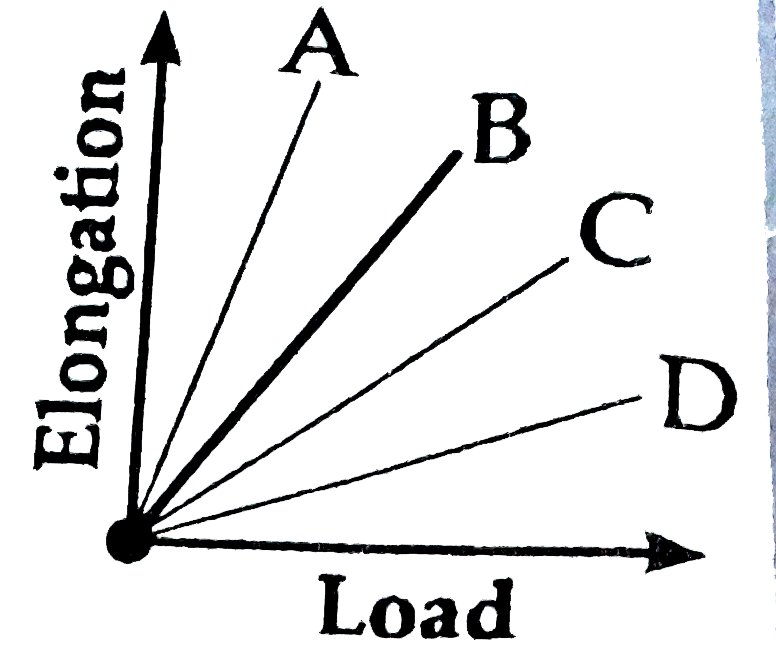The terminals of a battery are joined by a length of resistance wire. Which of the following changes, will decrease the current through the battery?
(i) Connecting an identical wire in series with the first one
(ii) Covering the wire with plastic insulation
(iii) Using a shorter wire of the same material and same thickness
(iv) Using a thinner wire of the same material and same length
(i) and (iv)
(ii) and (iii)
(i) and (iii)
(iii) and (iv)
The correct Answer is:A
To solve the problem, we need to determine which of the given changes will decrease the current flowing through the battery when a resistance wire is connected to it. The current (I) flowing through the circuit can be calculated using Ohm's Law, which states:
I=VR
where:
- I is the current,
- V is the voltage of the battery,
- R is the total resistance in the circuit.
To decrease the current, we need to increase the resistance R. Let's analyze each option:
1. Option (i): Connecting an identical wire in series with the first one.
- When two identical wires are connected in series, the total resistance increases. If the resistance of one wire is R, then the total resistance becomes R+R=2R.
- Therefore, the current will decrease because the total resistance has increased.
- Conclusion: This option will decrease the current.
2. Option (ii): Covering the wire with plastic insulation.
- Covering the wire with plastic insulation does not change the resistance of the wire itself. The resistance remains the same, and thus the current will not change.
- Conclusion: This option will not decrease the current.
3. Option (iii): Using a shorter wire of the same material and same thickness.
- A shorter wire will have a lower resistance compared to a longer wire. Since resistance is directly proportional to length, reducing the length decreases the resistance.
- Therefore, the current will increase.
- Conclusion: This option will not decrease the current.
4. Option (iv): Using a thinner wire of the same material and same length.
- A thinner wire has a smaller cross-sectional area, which increases the resistance (since resistance is inversely proportional to the area). Thus, if the thickness is reduced while keeping the length the same, the resistance increases.
- Therefore, the current will decrease.
- Conclusion: This option will decrease the current.
Final Answer:
The changes that will decrease the current through the battery are:
- (i) Connecting an identical wire in series with the first one.
- (iv) Using a thinner wire of the same material and same length.
- I is the current,
- V is the voltage of the battery,
- R is the total resistance in the circuit.
- When two identical wires are connected in series, the total resistance increases. If the resistance of one wire is R, then the total resistance becomes R+R=2R.
- Therefore, the current will decrease because the total resistance has increased.
- Conclusion: This option will decrease the current.
- Covering the wire with plastic insulation does not change the resistance of the wire itself. The resistance remains the same, and thus the current will not change.
- Conclusion: This option will not decrease the current.
- A shorter wire will have a lower resistance compared to a longer wire. Since resistance is directly proportional to length, reducing the length decreases the resistance.
- Therefore, the current will increase.
- Conclusion: This option will not decrease the current.
- A thinner wire has a smaller cross-sectional area, which increases the resistance (since resistance is inversely proportional to the area). Thus, if the thickness is reduced while keeping the length the same, the resistance increases.
- Therefore, the current will decrease.
- Conclusion: This option will decrease the current.
The changes that will decrease the current through the battery are:
- (i) Connecting an identical wire in series with the first one.
- (iv) Using a thinner wire of the same material and same length.
Topper's Solved these Questions
- NSO MODEL TEST PAPER -1BOOK - SCIENCE OLYMPIAD FOUNDATION CHAPTER - NSO MODEL TEST PAPER -1EXERCISE - ACHIEVERS SECTION
2 Videos
- LIGHTBOOK - SCIENCE OLYMPIAD FOUNDATION CHAPTER - LIGHTEXERCISE - ACHIEVERS SECTION (HOTS)
5 Videos
- NSO QUESTION PAPER 2017-18 SET-ABOOK - SCIENCE OLYMPIAD FOUNDATION CHAPTER - NSO QUESTION PAPER 2017-18 SET-AEXERCISE - ACHIEVERS SECTION
3 Videos
Similar Questions
Knowledge Check
_E01_007_Q01.png)
The load versus elongation graph for four wires of the same material and same length is shown in the figure. The hinnest wire is represented by the lineAOABOBCOCDODWhich of the following is correct statement from the given graph plotted, for four wires of same material and same thickness
 AA has largest lengthBD has largest lengthCC has least lengthDB has largest length
AA has largest lengthBD has largest lengthCC has least lengthDB has largest lengthThe extension of a wire by the application of a load is 2 mm. The extension in a wire of the same material and same length but half the radius by the same load is
A4 mmB6 mmC8 mmD12 mm
Two wires of same material and same length have radii r1andr2 respectively. Compare their resistances.
View SolutionWhich of the following wires, all made of the same material, has the highest resistance?
View SolutionThe extension of a wire by the application of load is 3mm. The extension in a wire of the same material and length but half the radius by the same load is
View SolutionThe dimensions of four wires of the same material an given below. In which wire the increase in the length will be maximum?
View SolutionThe resistance of a wire of uniform diameter d and length L is R . The resistance of another wire of the same material but diameter 2d and length 4L will be
View Solution
